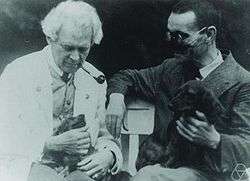Gaston Julia
| Gaston Julia | |
|---|---|
|
Gaston Julia (right), with Gustav Herglotz, comparing dogs | |
| Born |
3 February 1893 Sidi Bel Abbes, French Algeria |
| Died |
19 March 1978 (aged 85) Paris |
| Nationality | French |
| Fields | Mathematics |
| Institutions | University of Paris |
| Alma mater |
École Normale Supérieure University of Paris |
| Doctoral advisor |
Marie Georges Humbert Charles Émile Picard |
| Doctoral students | Jacques Dixmier |
| Known for | Julia set |
Gaston Maurice Julia (3 February 1893 – 19 March 1978) was a French mathematician who devised the formula for the Julia set. His works were popularized by French mathematician Benoit Mandelbrot; the Julia and Mandelbrot fractals are closely related.
Military service
Julia was born in the Algerian town of Sidi Bel Abbes, at the time governed by the French. During his youth, he had an interest in mathematics and music. His studies were interrupted at the age of 21, when France became involved in World War I and Julia was conscripted to serve with the army. During an attack he suffered a severe injury, losing his nose. His many operations to remedy the situation were all unsuccessful, and for the rest of his life he resigned himself to wearing a leather strap around the area where his nose had been.
Career in mathematics
Julia gained attention for his mathematical work after the war when a 199-page article he wrote was featured in the Journal de Mathématiques Pures et Appliquées, a French mathematics journal. The article, which he published in 1918 at the age of 25, titled "Mémoire sur l'itération des fonctions rationnelles" described the iteration of a rational function. The article gained immense popularity among mathematicians and the general population as a whole, and so resulted in Julia's later receiving of the Grand Prix de l'Académie des Sciences. Despite his fame, his works were mostly forgotten[1] until the day Benoit Mandelbrot mentioned them in his works.
On 19 March 1978, Julia died in Paris at the age of 85.
Julia was also father to Marc Julia,[2] the French organic chemist who invented the Julia olefination.
Books
- Oeuvres, 6 vols., Paris, Gauthier-Villars 1968-1970 (eds. Jacques Dixmier, Michel Hervé, with foreword by Julia).
- Leçons sur les Fonctions Uniformes à Point Singulier Essentiel Isolé, Gauthier-Villars 1924[3]
- Eléments de géométrie infinitésimale, Gauthier-Villars 1927
- Cours de Cinématique, Gauthier-Villars 1928, 2nd edition 1936[4]
- Exercices d'Analyse, 4 vols., Gauthier-Villars, 1928 - 1938, 2nd edition 1944, 1950
- Principes Géométriques d'Analyse, 2 vols., Gauthier-Villars, 1930,[5] 1932[6]
- Essai sur le Développment de la Théorie des Fonctions de Variables Complexes, Gauthier-Villars 1933[7]
- Introduction Mathématique aux Theories Quantiques, 2 vols., Gauthier-Villars 1936, 1938,[8] 2nd edition 1949, 1955
- Eléments d'algèbre, Gauthier-Villars 1959
- Cours de Géométrie, Gauthier-Villars 1941
- Cours de géométrie infinitésimale, Gauthier-Villars, 2nd edition 1953
- Exercices de géométrie, 2 vols., Gauthier-Villars 1944, 1952
- Leçons sur la représentation conforme des aires simplement connexes, Gauthier-Villars 1931, 2nd edition 1950
- Leçons sur la représentation conforme des aires multiplement connexes, Gauthier-Villars 1934
- Traité de Théorie de Fonctions, Gauthier-Villars 1953
- Leçons sur les fonctions monogènes uniformes d'une variable complexe Gauthier-Villars 1917
- Étude sur les formes binaires non quadratiques à indéterminées réelles ou complexes, ou à indéterminées conjuguées, Gauthier-Villars 1917
See also
- Mandelbrot set, discovered by Pierre Fatou and Julia
References
- ↑ Ari Ben-Menahem: Historical Encyclopedia of Natural and Mathematical Sciences, Springer, ISBN 978-3-540-68832-7, p. 3427
- ↑ Chottard, Jean-Claude; Lallemand, Jean-Yves; Mansuy, Daniel; Verpeaux, Jean-Noël (2010). "Marc Julia (1922-2010)". Angewandte Chemie International Edition 49 (48): 9038–9039. doi:10.1002/anie.201006207
- ↑ Ritt, J. F. (1925). "Review: Leçons sur les Fonctions Uniformes à Point Singulier Essentiel Isolé, by Gaston Julia" (PDF). Bull. Amer. Math. Soc. 31 (7): 359–360. doi:10.1090/s0002-9904-1925-04056-2.
- ↑ Campbell, J. W. (1937). "Review: Cours de Cinématique, by Gaston Julia" (PDF). Bull. Amer. Math. Soc. 43 (5): 600–601. doi:10.1090/s0002-9904-1937-06585-2.
- ↑ Snyder, Virgil (1930). "Review: Principes Géométriques d'Analyse, by Gaston Julia" (PDF). Bull. Amer. Math. Soc. 36 (11): 789. doi:10.1090/s0002-9904-1930-05055-7.
- ↑ Seidel, W. (1933). "Review: Principes Géométriques d'Analyse, Deuxième Partie, by Gaston Julia" (PDF). Bull. Amer. Math. Soc. 39 (1): 15–16. doi:10.1090/s0002-9904-1933-05533-7.
- ↑ Curtiss, D. R. (1934). "Review: Essai sur le Développment de la Théorie des Fonctions de Variables Complexes, by Gaston Julia" (PDF). Bull. Amer. Math. Soc. 40 (7): 521. doi:10.1090/s0002-9904-1934-05890-7.
- ↑ Stone, M. H. (1939). "Review: Introduction Mathématique aux Theories Quantiques, Part 2, by Gaston Julia" (PDF). Bull. Amer. Math. Soc. 45 (1): 59–60. doi:10.1090/s0002-9904-1939-06921-8.
External links
- O'Connor, John J.; Robertson, Edmund F., "Gaston Julia", MacTutor History of Mathematics archive, University of St Andrews.
- Gaston Julia at the Mathematics Genealogy Project
- Memoir on iteration of rational functions, English translation in parts: 1/7,2/7, 3/7,4/7,5/7,6/7,7/7.
- Downloadable articles at Numdam.
- Christoph Dötsch, Dynamik meromorpher Funktionen auf der Riemannschen Zahlenkugel, Diplomica GmbH Hamburg (2008)
